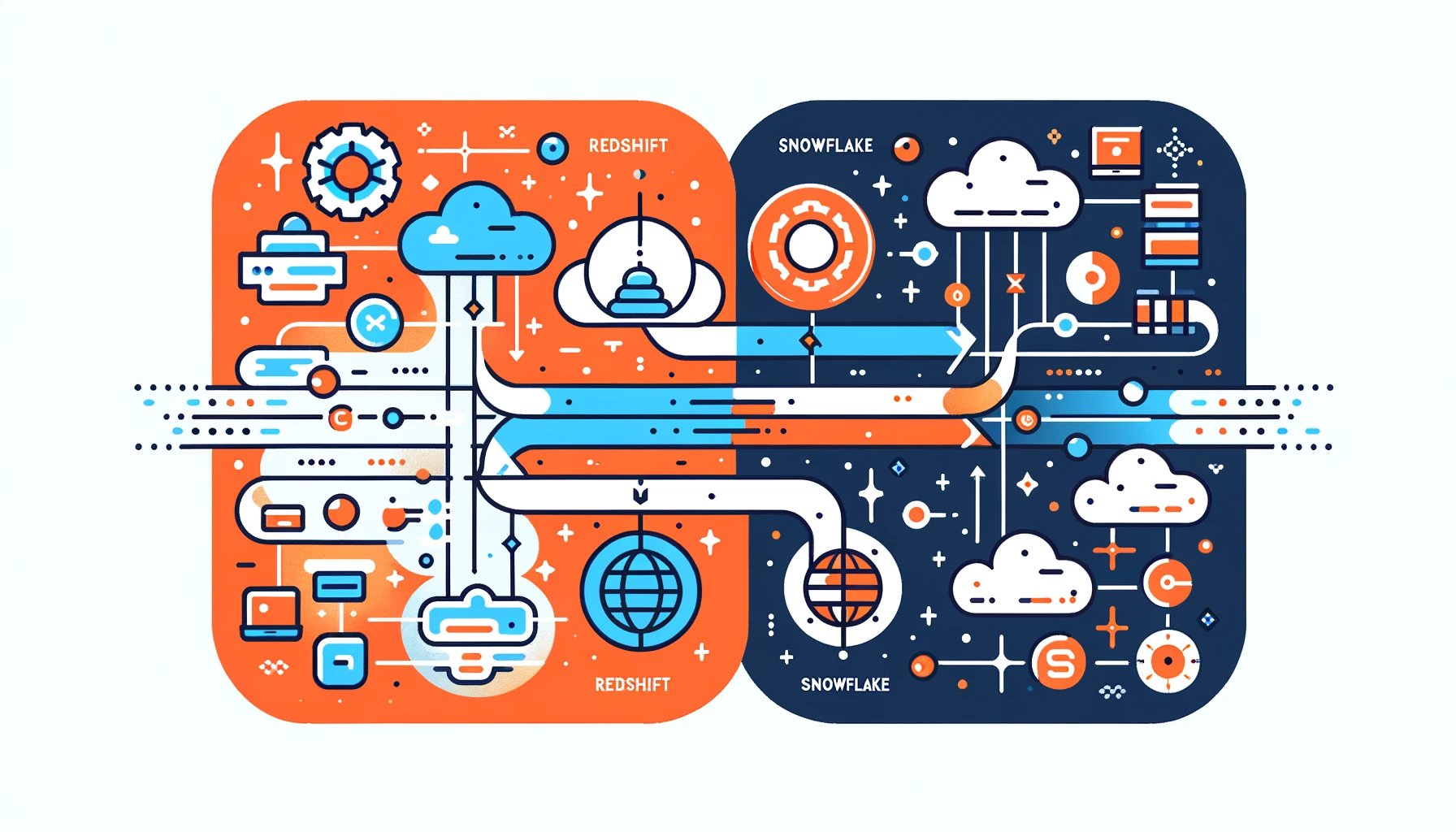
Redshift vs Snowflake

Introduction
Businesses need to choose the right data warehouse solution in today’s data-driven world. This is crucial for effectively harnessing the power of their data. Amazon Redshift and Snowflake are two popular options in the market known for their strong features.
This article aims to provide an in-depth comparison between these two cloud storage giants. Hope it will help you make an informed decision when selecting a data warehousing solution for your organization.
Understanding Redshift and Snowflake
Before diving into the comparison, let’s briefly understand what Redshift and Snowflake are and their key features.
Amazon Redshift
Amazon Redshift is a fully managed, petabyte-scale data warehouse service provided by Amazon Web Services (AWS). It is a powerful data warehousing solution to handle large-scale data storage. It offers high performance and scalability, making it ideal for organizations dealing with massive amounts of data.
One of the key features of Redshift is its columnar storage approach, which stores data in columns rather than rows. This allows for faster query performance and more efficient data compression, resulting in quicker data retrieval and analyzing.
Additionally, Redshift utilizes a massively parallel processing (MPP) architecture, which distributes data processing tasks across multiple nodes in a cluster. This parallel processing approach enables Redshift to handle complex queries and large datasets. It does processing with ease, delivering fast query performance and scalability.
Overall, Redshift is a robust and efficient data warehousing solution. It suits organizations looking to derive insights from large volumes of data. Its columnar storage approach and MPP architecture make it a powerful tool for handling complex data. Including its analysis tasks and delivering high performance results.
Snowflake data warehouse
Snowflake is a cloud-based solution for data warehousing, integration, and analytics, all in one platform. It offers a unique architecture that separates compute and storage, allowing users to scale them independently. It is a cloud-based platform for storing data in different formats like structured, semi-structured, and unstructured data. This means that users can easily store and analyze data in formats such as CSV, JSON, Parquet, Avro, and more.
Snowflake has a SQL-like interface that lets users write queries and manipulate data using SQL syntax. This makes it easy for users who are already familiar with SQL to work with Snowflake without having to learn a new query language.
Snowflake not only helps with querying and manipulating data, but also offers tools for data management, security, and collaboration. Users can easily create and manage data warehouses, set up access controls, and share data with colleagues and partners.
Snowflake is a user-friendly platform that allows users to securely store, analyze, and share data easily. Many organizations choose this tool because it supports various data formats. It also has a SQL-like interface, which makes it easy to use for analyzing data.
Market Landscape
In addition to Redshift and Snowflake, there are several other notable players in the data warehousing and analytics market. Some of these include:
- Google BigQuery
- Microsoft Azure Synapse Analytics
- Oracle Autonomous Data Warehouse
- IBM Db2 Warehouse on Cloud
Each of these solutions has its own strengths and target audience, catering to different business requirements and use cases.
Why Compare Redshift and Snowflake?
Redshift and Snowflake are two of the most popular and feature-rich data warehouse solutions available today. They both offer scalability, performance, and flexibility, making them suitable for a wide range of industries and data volumes. Organizations can compare the two solutions to determine their specific needs. They can then decide which solution aligns better with their data strategy and budget.
Key Differences and Considerations
Scalability and Performance
Both Redshift and Snowflake excel in scalability and performance. However, they have different approaches to achieving this:
Redshift uses a cluster-based architecture, where you can scale by adding or removing nodes in the cluster. It offers fast query performance through its columnar storage and MPP architecture.
You can adjust the size of a Redshift cluster using the AWS Management Console or API. You can choose the number of nodes and their type. For example, you can make the cluster bigger or smaller.
Snowflake, on the other hand, separates compute and storage, allowing you to scale them independently. You can instantly scale up or down the compute resources based on workload demands without affecting storage.
For example, in Snowflake, you can easily adjust the size of a virtual warehouse using the ALTER WAREHOUSE command. This allows you to specify the number of clusters or set auto-scaling parameters.
Data Loading and Integration
Redshift and Snowflake provide different mechanisms for loading and integrating data:
Redshift offers various data loading options, such as using the COPY command to load data from other AWS services. Amazon S3, Amazon DynamoDB, etc. It also supports parallel data loading for improved performance.
Example:
COPY users FROM 's3://my-bucket/users.csv' IAM_ROLE 'arn:aws:iam::123456789012:role/RedshiftLoadRole' FORMAT AS CSV;
Snowflake provides a seamless data integration experience through its support for various data formats and connectors. It allows loading data using the COPY INTO command from various sources, including cloud storage services and external databases.
Example:
COPY INTO users FROM @my_stage/users.csv FILE_FORMAT = (TYPE = CSV);
Security and Compliance
Data security and compliance are critical aspects of any cloud-based data warehouse solution. Both Redshift and Snowflake offer robust security features:
Redshift provides encryption for stored and transferred data. It also offers detailed access control through AWS Identity and Access Management (IAM) roles and policies and supports VPC (Virtual Private Cloud) for network isolation.
Snowflake encrypts data when storing it and transferring it. It also has role-based access control for added security. RBAC enables the implementation of specific security measures based on user roles. It provides secure data sharing capabilities, allowing organizations to share live, governed data across regions and cloud platforms.
Pricing Models
Redshift and Snowflake have different pricing models, which can impact the total cost of ownership:
Redshift follows a pay-as-you-go pricing model based on the type and number of nodes in the cluster. It charges for the compute resources used on an hourly basis, with additional costs for storage and data transfer.
Snowflake uses a unique pricing model based on separate compute and storage costs. Compute resources (virtual warehouses) by the second define charges. Snowflake charges for storage monthly. This allows for more flexible and granular cost control.
Choosing Between Redshift and Snowflake
The choice between Redshift and Snowflake depends on various factors specific to your organization’s needs, such as:
- Existing AWS ecosystem and familiarity with AWS services
- Compatibility with existing data sources and tools
- Specific performance and scalability requirements
- Security and compliance needs
- Budget and pricing preferences
Evaluating these factors carefully and considering the long-term goals of your data warehousing strategy is essential.
Conclusion
Redshift and Snowflake are both powerful data warehouse solutions that offer scalability, performance, and advanced features. Redshift utilizes the AWS ecosystem and seamlessly integrates with other AWS services.
Snowflake has a unique architecture that separates compute and storage, providing flexibility and cost savings. This makes Snowflake stand out from other platforms.
Ultimately, the choice between Redshift and Snowflake depends on your specific business requirements, existing infrastructure, and data strategy. To make a good decision, you should evaluate your needs, compare features and pricing, and do proof-of-concept tests.
Carefully considering what you need is important. You should also compare the features and pricing of each solution. Lastly, it can be helpful to conduct proof-of-concept tests.
DataSunrise: Exceptional Tools for Redshift and Snowflake
DataSunrise provides exceptional and flexible tools for securing and managing your data warehouse. It covers both Redshift and Snowflake platforms. You can implement robust security measures, define audit rules, apply data masking, and ensure compliance with various regulations.
DataSunrise seamlessly integrates with Redshift and Snowflake, providing a comprehensive solution for data protection and governance. If you want to see how DataSunrise can improve your data storage, please contact our team for an online demo. Our experts will be happy to showcase the capabilities of our software and discuss how it can benefit your organization.
Visit DataSunrise to learn more and schedule your demo today!
